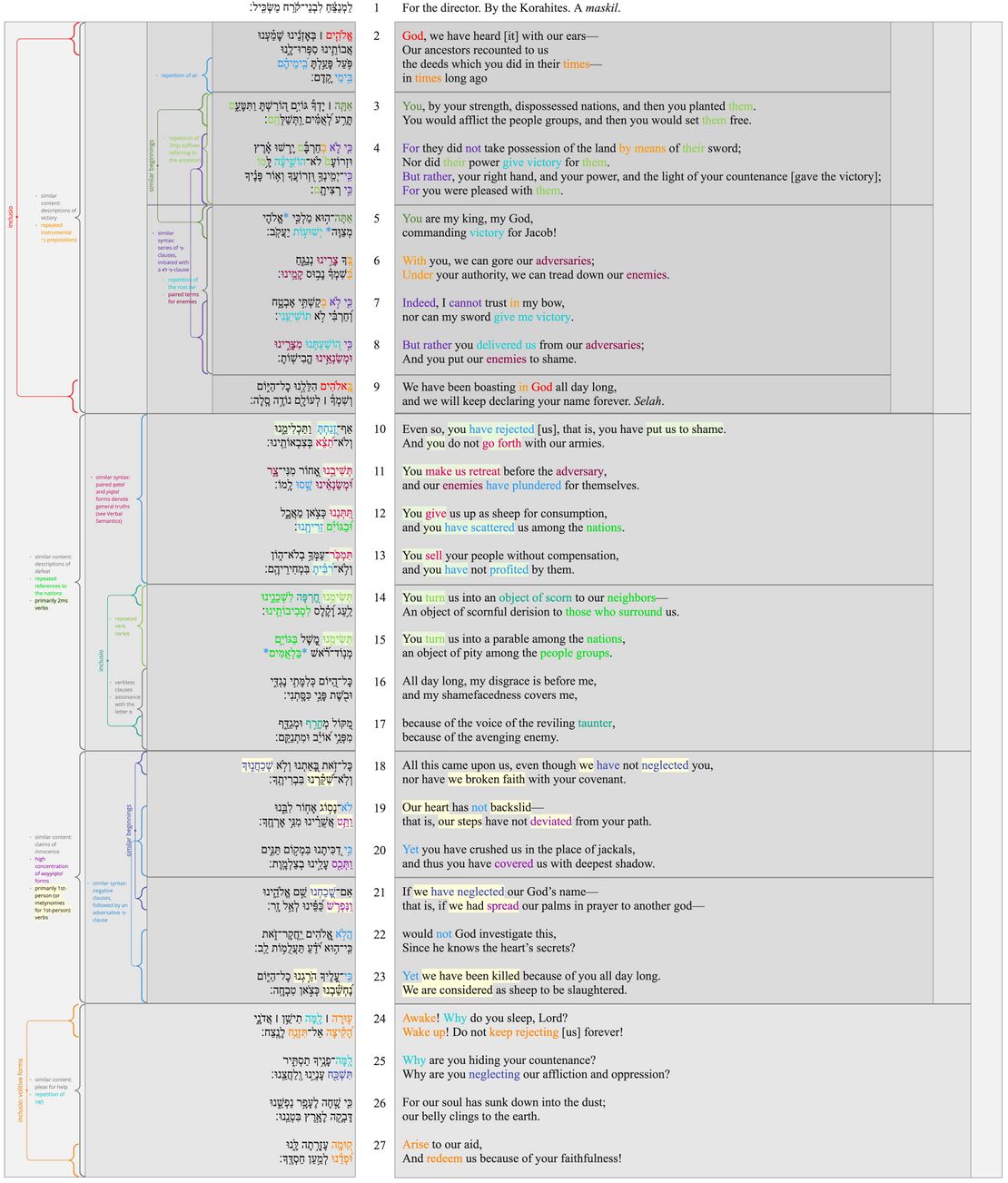Psalm 44 Poetic Structure
Poetic Structure
In poetic structure, we analyse the structure of the psalm beginning at the most basic level of the structure: the line (also known as the “colon” or “hemistich”). Then, based on the perception of patterned similarities (and on the assumption that the whole psalm is structured hierarchically), we argue for the grouping of lines into verses, verses into sub-sections, sub-sections into larger sections, etc. Because patterned similarities might be of various kinds (syntactic, semantic, pragmatic, sonic) the analysis of poetic structure draws on all of the previous layers (especially the Discourse layer).
Poetic Macro-structure
If an emendation or revocalization is preferred, that emendation or revocalization will be marked in the Hebrew text of all the visuals.
| Emendations/Revocalizations legend | |
|---|---|
| *Emended text* | Emended text, text in which the consonants differ from the consonants of the Masoretic text, is indicated by blue asterisks on either side of the emendation. |
| *Revocalized text* | Revocalized text, text in which only the vowels differ from the vowels of the Masoretic text, is indicated by purple asterisks on either side of the revocalization. |
Notes
- **v. 5: For the emendation of the MT אֱלֹהִ֑ים צַ֝וֵּ֗ה see Method:Grammar Layer note.
- **v. 15b: For the emendation of the MT בַּל־אֻמִּֽים׃ see Method:Grammar Layer note.
- It is possible to divide Ps 44 into three main parts: (1) vv. 1–9, a celebration of God's deliverance; (2) vv. 10–17, a lament over defeat and humiliation, and (3) vv. 18–27, a grievance and petition for help (so Fokkelman 2003, 63). However, the concentration of volitive forms (imperatives and jussives) in vv. 24–27—which also forms an inclusio for the section—suggests that these verses constitute a fourth stanza.
- v. 2: While it is possible to view v. 2 as constituting its own introductory section (so Terrien 2003, 358), it seems preferable to treat it as part of the larger section of vv. 2–9. The (fronted) divine title אֱלֹהִים in v. 2 also appears in v. 9, forming an inclusio.
- vv. 2–9: This first stanza of the psalm is characterized by recountings of God-driven victories over his people's enemies. The stanza as a whole is marked off by the inclusio אֱלֹהִים. The instrumental ב preposition, used throughout this section, underscores the major theme of this stanza, i.e., the means of Israel's military deliverance.
- v. 5: As one of only two nominal clauses in this psalm (the other occurring in v. 16), this verse stands out as a pivot point in this initial stanza of the psalm. It also represents a transition between recounting past deliverances and proclaiming (likely proverbial) present victories.
- vv. 2–4: The first strophe of the stanza features 3mp pronominal suffixes throughout, highlighting its concern with God's dealings with the ancestors.
- vv. 5–9: Despite a transition to a new movement of the psalm, this second strophe of the stanza echoes themes found in the first half. Repeated mentions of the root ישׁע echo the initial instance of the root in v. 4. Furthermore, both halves of the stanza conclude with discourse-level כִּי לֹא clauses (denying the power of human might), followed by adversative כִּי clauses (contrasting human might with divine power).
- vv. 10–17: This second stanza is characterized by descriptions of Israel's defeat and humiliation. It can be further divided thematically between descriptions of defeat (vv. 10–13) and humiliation (vv. 14–17). These distinct sections are also signaled by the use of paired qatal-yiqtol verbal constructions in vv. 10–13 and the repeated תְּשִׂימֵ֣נוּ in vv. 14 and 15. In contrast with the third stanza that follows, this second stanza features primarily 2ms verb forms referring to God, highlighting his agency (and responsibility) in this lament.
- vv. 16–17: With v. 5, v. 16a is the only instance of a nominal clause in this psalm. Given the predominance of verbal clauses throughout the psalm, this makes the clause stand out at the end of this stanza. In v. 17, the piling on of terminology, coupled with the assonance of the letter מ (Schaefer 2001, 112), appear to build up to an emotional climax for the psalm. This provides the springboard for the following stanza, and the psalmist's protestation of innocence.
- vv. 18–23: The fronted כָּל־זֹאת of v. 18 signals a transition (Lugt 2010, 25) and indicates topic shift, thus suggesting the beginning of a new stanza (see Macrosyntax). This stanza is characterized by two strophes with parallel syntactic features: in each strophe, the verb שׁכח (vv. 18, 21) is followed by a negative clause (vv. 19, 22), which then sets up a contrast with an adversative כִּי-clause (vv. 20, 23). Also, in contrast with the preceding stanza, these verses feature primarily first-person verbs, or verbs for body parts standing as metonymies for the first-person speaker. This focuses the readers attention on Israel throughout this stanza, as the psalmist makes the case for their covenant faithfulness.
- vv. 24–27: This final section is distinct due to its concentration of volitive forms in vv. 24 and 27. Furthermore, interrogative particles such as לָמָּה (vv. 24, 25) tend to occur at the beginning of strophes (Lugt 2006, 79). Applying these phenomena yields a stanza composed of three strophes (v. 24; vv. 25–26; v. 27), with two supplications bracketing an interrogative lament.
Line Divisions
Line division divides the poem into lines and line groupings. We determine line divisions based on a combination of external evidence (Masoretic accents, pausal forms, manuscripts) and internal evidence (syntax, prosodic word counting and patterned relation to other lines). Moreover, we indicate line-groupings by using additional spacing.
When line divisions are uncertain, we consult some of the many psalms manuscripts which lay out the text in lines. Then, if a division attested in one of these manuscripts/versions influences our decision to divide the text at a certain point, we place a green symbol (G, DSS, or MT) to the left of the line in question.
| Poetic line division legend | |
|---|---|
| Pausal form | Pausal forms are highlighted in yellow. |
| Accent which typically corresponds to line division | Accents which typically correspond to line divisions are indicated by red text. |
| | | Clause boundaries are indicated by a light gray vertical line in between clauses. |
| G | Line divisions that follow Greek manuscripts are indicated by a bold green G. |
| DSS | Line divisions that follow the Dead Sea Scrolls are indicated by a bold green DSS. |
| M | Line divisions that follow Masoretic manuscripts are indicated by a bold green M. |
| Number of prosodic words | The number of prosodic words are indicated in blue text. |
| Prosodic words greater than 5 | The number of prosodic words if greater than 5 is indicated by bold blue text. |
If an emendation or revocalization is preferred, that emendation or revocalization will be marked in the Hebrew text of all the visuals.
| Emendations/Revocalizations legend | |
|---|---|
| *Emended text* | Emended text, text in which the consonants differ from the consonants of the Masoretic text, is indicated by blue asterisks on either side of the emendation. |
| *Revocalized text* | Revocalized text, text in which only the vowels differ from the vowels of the Masoretic text, is indicated by purple asterisks on either side of the revocalization. |
Notes
- **v. 15b: For the emendation of the MT בַּל־אֻמִּֽים׃ see Method:Grammar Layer note.
- v. 2c: While the revia mugraš of בִֽ֝ימֵיהֶ֗ם does not tend to correspond to line divisions (cf. de Hoop and Sanders 2022, 35), it seems likely that it is doing so in this case. Reading v. 2 without a line division at this point results in an unbalanced 3-2-5 tricolon, whereas dividing the lines at the revia mugraš results in a pair of 3-2 bicola (cf. Craigie 2004, 330).
- vv. 2d–3a: Some scholars have suggested that אַתָּה יָדְךָ "you, your hand" in v. 3a should be placed at the end of v. 2d for metrical reasons. This would involve moving the soph pasuq of v. 2 forward to יָדְךָ in v. 3a (so Fokkelman 2003, 64–65) and/or emending the MT (e.g., בְיָדְךָ in place of אַתָּה יָדְךָ, so BHS). However, the MT divisions are supported by the LXX, Targum, and Syriac. Furthermore, placing אַתָּה יָדְךָ with v. 2d would imply that אַתָּה is the subject of פָּעַלְתָּ "you did," with יָדְךָ functioning appositionally (Fokkelman 2003, 65), resulting in the unusual rendering, "the works you, your hand, did..." (cf. NEB, "all the deeds which thou didst in their days, all the work of thy hand in days of old"). It seems preferable to take אַתָּה יָדְךָ with v. 3a, with אַתָּה functioning as a left-dislocated element (see Method:Grammar Layer note). This would also preserve the syntactic parallel with v. 5, which serves as a thematic pivot point (see Poetic Structure above).
- v. 4b: In BHS/BHK (cf. also Aleppo and Sassoon codices), in instances where a word bearing the ole weyored has its primary stress on the first syllable, the ole (<) appears on the preceding word (Price 2010, 191). This is the case with הוֹשִׁ֪יעָ֫ה לָּ֥מוֹ, and the resulting line division should be read at לָּמוֹ. Furthermore, as words joined by the ole weyored constitute a prosodic word (see CG), the resulting bicolon of v. 4a-b has a relatively unbalanced 5-2 prosodic-word meter. However, the lines are fully balanced if measured on the basis of syllable count (9-9).



